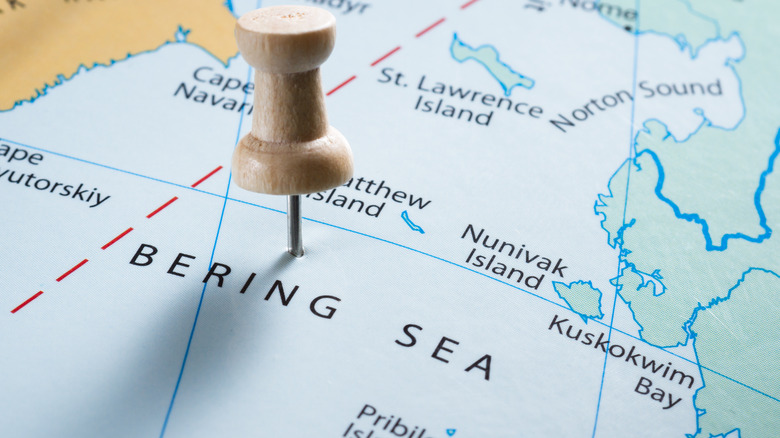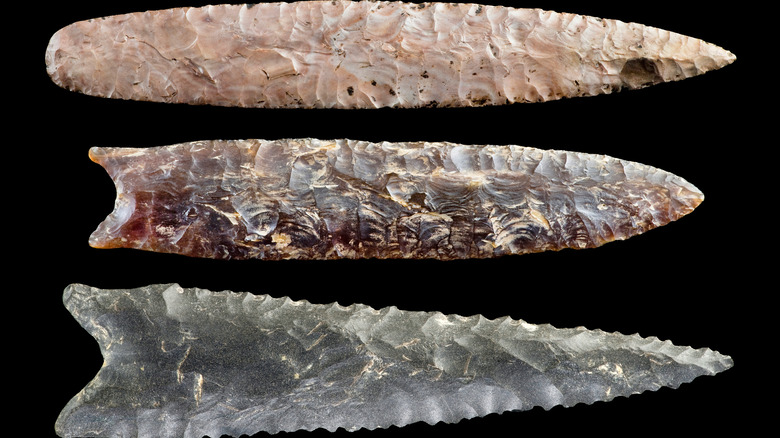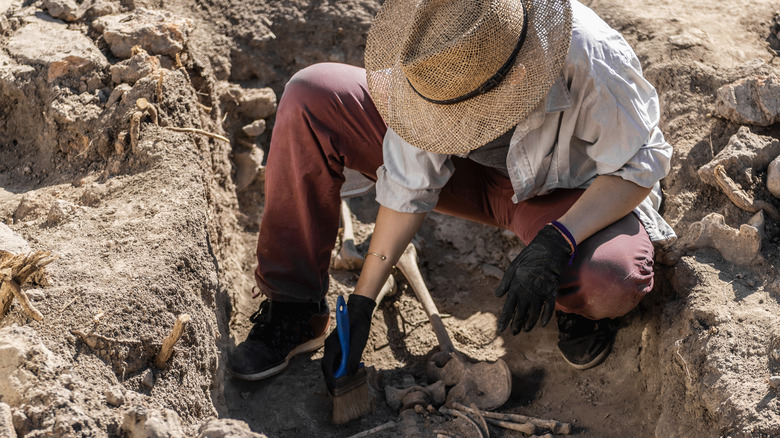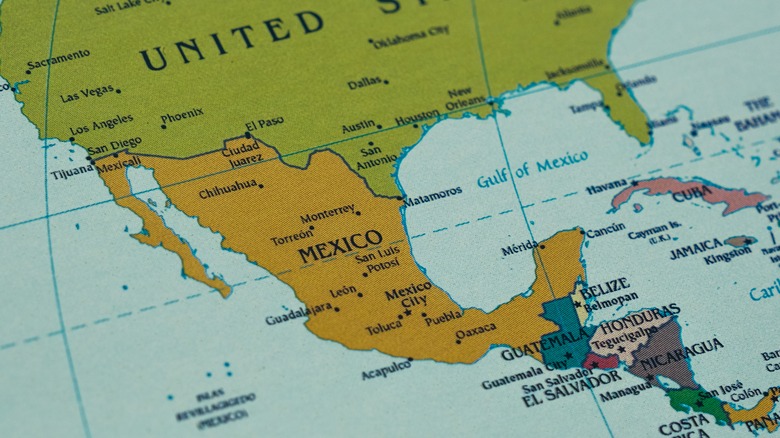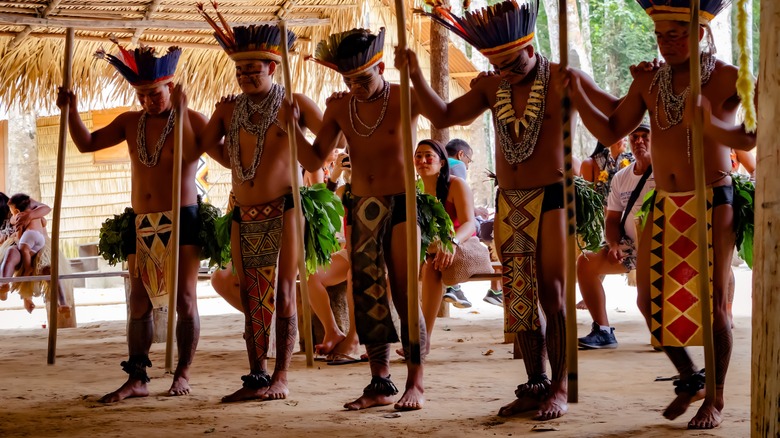The Study That Sheds Doubt On The Clovis First Theory
As the story goes, the first people in the New World arrived approximately 13,000-11,000 years ago. These brave nomads are said to have pursued their prey through the icy corridor that broke within the glaciers that covered much of North America (via Big Think). From there, the fur-clad people migrated throughout the Western Hemisphere, leaving behind traces of their path in the form of stone tools known to archaeologists as Clovis points. They first emerged from the soil of Clovis, New Mexico in 1929. From then on, remarkably similar arrowheads — leaf-shaped with concave bases and a short flute for hafting — appeared across North America, per Britannica.
Over the years, dates older than 13,000 years have cropped up on archaeological sites in North and South America, causing some earnest skepticism of the single migration theory. Yet most archaeologists have received these pre-Clovis dates with an equal amount of skepticism, claiming the dates may have been flawed. But the evidence against the Bering Strait migration has mounted, with cutting-edge science revealing that humans inhabited the Americas long before the glacial corridor was exposed.
The History of the Clovis Culture
The Clovis people, otherwise called Paleoindians, originated from Asia and are said to be the likely ancestors of modern Native Americans. Genetic evidence showed that Native Americans diverged from populations in Siberia between 24,900 and 18,400 years ago. Still, this evidence does not rule out multiple migration routes, from Beringia to the Pacific Ocean, since DNA only proves one population became isolated from another, per the National Library of Medicine. What led this Siberian population to separate is a bit murky, but theories state that migrating mammoths, mastodons, bison, and other fauna propelled the group to Beringia, per the British Museum.
According to the Pennsylvania Historical & Museum Commission, once they reached North America, their migration across the continent down to South America took place over 2,500 years. Their swift migration south is said to have resulted in the continent's megafauna extinction. It is known as the "overkill hypothesis," which states that Paleoindians spread out rapidly in pursuit of prey and ultimately became an invasive predator. Despite genetic evidence showing strong support for Siberian ancestry and mass migration in the New World, some archaeologists expressed doubt about these theories.
Pre-Clovis Theories Come to Light
The migration pattern of the first Americans is anthropologically important and makes us ask how cultures travel and diversify. Whether it happens gradually or rapidly is an intriguing problem, as well as understanding how a single population can lead to the immense diversity in Native American cultures. Some archaeologists propose that a pre-Clovis migration occurred up to 30,000 years ago, thus allowing for more time to cover environmentally diverse regions both north and south. A site in Meadowcroft Rockshelter in Pennsylvania came up with a date of 19,400 years, with another site in Virginia showing a similar date. Other old sites include Buttermilk Creek, Texas, and Page-Ladson, Florida, as per Pennsylvania Historical & Museum Commission.
Older dates at the southernmost tip of South America also shed doubt on the Clovis First theory and support the likelihood of multiple migrations. National Geographic reported that new radiocarbon dates indicate that — if the Clovis First model is accurate — they would have had only 200 years to make it to the tip of South America; an unlikely event. John Johnson, an archaeologist at the Santa Barbara Museum of Natural History called early migrations "a process with people probably arriving at different times and taking different routes and potentially coming from different places." Although this was primarily speculative, later data would mount to support his statement.
Whose Dates are to be Trusted?
Some questionable dates have popped up in archaeology over the years, with Hueyatlaco, Mexico holding an exceptionally old date of over 200,000 years, which archaeologists deem anomalous (via The Washington Post). One other site in Mexico was rejected by some archaeologists because the artifacts may have been geofacts — rocks that have weathered in such a way that they look like stone tools (per Smithsonian). Although obtaining the oldest dates is rife with controversy, and sometimes conspiracy theories, many dates have held up.
Studies in Texas have found dates between 14,000 and 15,000 years ago for sites at Paisley Cave and Buttermilk Creek, per Science. Page Ladson, Florida yielded a date of 14,550 years old (via the University of Minnesota). These sites have called into question the migration pattern of early Americans, especially given the time it would have taken for people to arrive in these regions. In 2016, a study offered the most robust evidence against the single Bering Strait migration when it found evidence that the pathway opened too late for these early inhabitants.
New Research Supports Pacific Coast Migration
In 2016, a study published by Cambridge showed the results of a radiocarbon test that indicated the ice-free path was not available to cross until 11,000 years ago. Furthermore, a March 2022 study used cosmogenic nuclide exposure dating to figure out how long the rocks in that region had spent exposed after the glaciers retreated. The study determined that the corridor opened around 13,800 years ago, "give or take 500 years," according to Jorie Clark of Oregon State University, who led the research team. Although areas of the corridor were exposed early on, researchers say it opened gradually and had not cut a full path until after humans populated the Americas (via Big Think).
Clark and his team favor the "Pacific Coast Migration Model," which claims humans traveled down the Pacific coast rather than through Canada, per Big Think. As far-fetched as this idea may seem, maritime travel in Southeast Asia was likely well underway by the time of New World habitation. In fact, there's strong evidence that humans covered the seas to make it to Australia up to 50,000 years ago or more. According to a 2019 study in Scientific Reports, the people of New Guinea, the Aru Islands, and Australia made sea voyages of up to 100 kilometers in prehistoric times.
Does the New Data Agree with DNA Evidence?
While some want to argue that Europeans may have had a prehistoric presence in the New World, with Kennewick Man having once led people to believe this was possible, DNA evidence still points to the Siberian region. Curiously, however, a 2018 article in Science reported traces of Australasian ancestry in ancient South American populations, and these traces do not seem to exist in North America. The researchers suggested that some groups carrying the genes may have moved through Beringia isolated from other populations, but with new evidence, it becomes more plausible that multiple migrations occurred.
The DNA evidence came from 64 individuals in South America, which they compared to the Anzick child — a 12,700-year-old member of the Clovis culture. Enough similarities existed to prove that there was a genetic relationship between the Clovis people of North America and South Americans, but questions remain. The researchers noted sites of up to 14,500 years old that led University of Alaska archaeologist Ben Potter to state (via Science), "We have a huge, gaping hole in the central and eastern North American [sampling] record." He added, "These papers aren't the final words."
